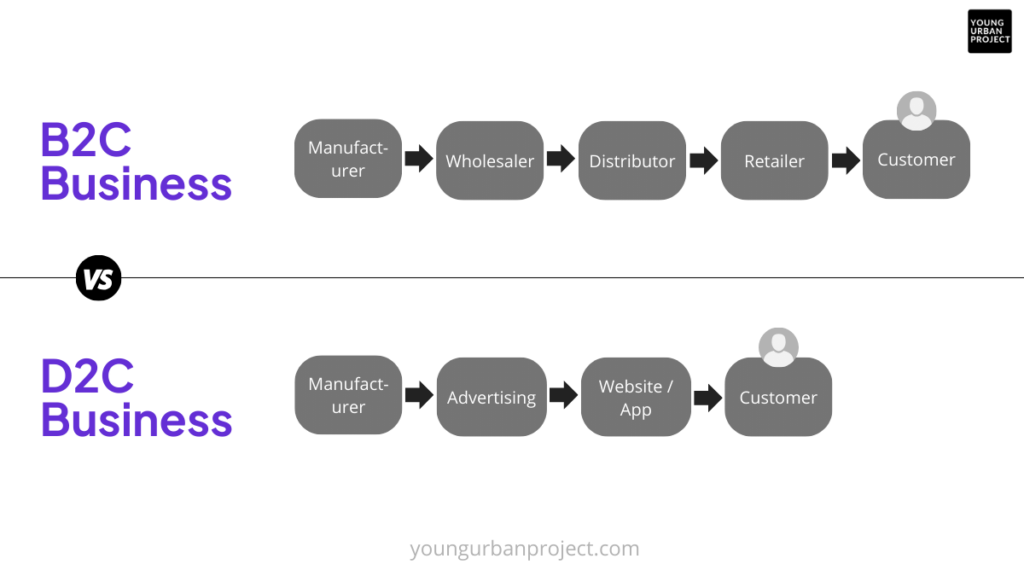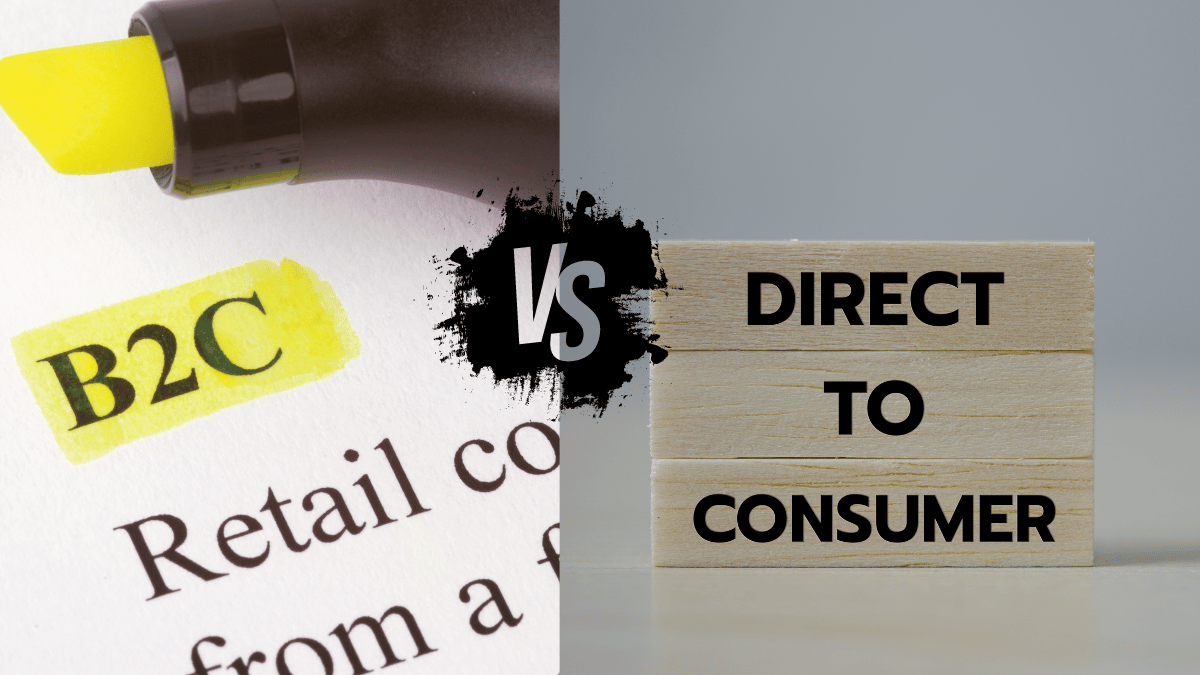B2C (Business to Consumer) and D2C (Direct to Consumer) are prevalent models in today’s e-commerce or retail industry. While they might seem similar at first glance, they have distinct differences that can significantly impact the business strategy, operations, and customer relationships.
In this blog post, we will get into the nuances and understand the differences between B2C vs D2C, making this a comprehensive guide for you.
Table of Contents
What is B2C?
B2C, or Business to Consumer, refers to the process of selling products or services directly to consumers. This model encompasses a wide range of businesses, from retail giants like Walmart, Reliance trends, and Amazon to small local shops.
In a B2C model, businesses act as intermediaries between manufacturers and consumers, often operating through physical stores (Godrej Nature’s Basket), online marketplaces (Flipkart, Nykka), or both.
Key Characteristics of B2C
- Intermediary Role: B2C Businesses purchase products from manufacturers or wholesalers and sell them to consumers(or customers).
- Wide Product Portfolio: B2C businesses often carry a broad selection of products to cater to diverse consumer needs.
- Marketing Focus: These businesses generally deploy heavy investment in marketing and advertising to attract and retain customers.
- Customer Experience: B2C businesses have a greater emphasis on providing a seamless shopping experience, both online and offline.
What is D2C?
D2C, or Direct to Consumer, is a business model where manufacturers sell their products directly to consumers, bypassing traditional retail intermediaries. This model has gained popularity with the rise of e-commerce and social media, enabling brands to build direct relationships with their customers.
Some examples of D2C businesses are: Dollar Shave Club, Warby Parker, BoAt, etc.
Key Characteristics of D2C
- Direct Sales: Manufacturers sell directly to consumers through their own websites or branded stores or via aggregator marketplaces.
- Control Over Branding: Greater control over brand messaging, customer experience, and pricing.
- Data-Driven: Utilization of customer data to personalize marketing and improve product offerings.
- Niche Products: Often focus on specialized or niche products that cater to specific customer needs.
Differences Between B2C and D2C

Distribution Channels
| B2C | D2C |
| Relies on a network of wholesalers, retailers, and online marketplaces to reach consumers. | Eliminates intermediaries, selling directly through branded websites, social media, and sometimes physical pop-up stores. |
Customer Relationship
| B2C | D2C |
| Interaction with customers is often transactional, with limited opportunities for direct engagement. | Direct engagement with customers allows for personalized experiences and stronger brand loyalty. |
Marketing Strategies
| B2C | D2C |
| Broad marketing campaigns aimed at reaching a wide audience through various channels such as TV, print, and digital ads. | Targeted digital marketing, often leveraging social media, influencers, and email marketing to build a community around the brand. |
Pricing and Margins
| B2C | D2C |
| Prices can be higher due to markups from intermediaries; margins are often shared with retailers and distributors. | Potential for lower prices and higher margins as products are sold directly without intermediary markups. |
Inventory Management
| B2C | D2C |
| Requires large-scale inventory management to stock multiple retail locations and fulfill online orders. | Can adopt just-in-time manufacturing and drop-shipping models to reduce inventory costs. |
B2C vs D2C Examples
B2C Examples
- Amazon: A quintessential B2C business, Amazon purchases products from various suppliers and sells them directly to consumers through its vast online marketplace.
- Walmart: Another retail giant, Walmart operates both physical stores and an online platform, providing a wide range of products from different brands.
- Ola: A ride-hailing company that has also expanded into manufacturing electric vehicles (EVs).
- BookMyShow: One of the most iconic Indian companies that helps people book tickets for movies, events, and experiences.
D2C Examples
- Warby Parker: An eyewear brand that disrupted the traditional retail model by selling prescription glasses directly to consumers online, offering home try-ons and free returns. Lenskart from India has had a similar model.
- Glossier: A beauty brand that leverages social media and customer feedback to create and sell products directly to its audience, fostering a strong community around its brand.
- BoAt: One of the most prominent D2C startups to have come out of India, BoAt makes and sells audio products. Founded by Aman Gupta (also a Shark on Shark Tank India), BoAt has also entered smart wearables.
- Licious: This is one of the most successful meat delivery startups in India.
Pros and Cons of B2C and D2C
| B2C Pros | B2C Cons |
| Established Networks: Leveraging established retail and distribution networks can lead to wider reach and quicker market entry. Brand Recognition: Partnering with well-known retailers can enhance brand credibility and visibility. Resource Efficiency: Sharing marketing and operational costs with intermediaries can be more resource-efficient. | Lower Margins: Shared margins with intermediaries can reduce profitability. Limited Control: Less control over customer experience, branding, and pricing. Complex Logistics: Managing inventory across multiple retail channels can be challenging. |
D2C Pros
| D2C Pros | D2C Cons |
| Higher Margins: Direct sales eliminate intermediary costs, leading to higher profit margins. Customer Insights: Direct interaction with customers provides valuable data for personalized marketing and product development. Brand Loyalty: Stronger brand-customer relationships can foster loyalty and repeat business. | Marketing Costs: Higher initial investment in marketing and brand building. Operational Challenges: Handling all aspects of the business, from manufacturing to fulfillment, can be resource-intensive. Scalability: Rapidly scaling a D2C business can be challenging without the support of established retail networks. |
Choosing the Right Model for Your Business
Consider Your Product
- Mass-Market vs. Niche: B2C might be more suitable for mass-market products that require broad distribution, while D2C is ideal for niche products that benefit from direct customer engagement.
Evaluate Your Resources
- Financial and Operational Capabilities: Assess your financial resources, operational capabilities, and expertise to determine whether you can handle the demands of a D2C model or if partnering with retailers is more feasible. Tools like Delivery Management Software can simplify logistics and streamline operations.
Customer Relationship Goals
- Long-Term Loyalty vs. Immediate Sales: Consider whether your business aims to build long-term customer relationships or to achieve immediate sales through broad distribution channels.
Market Trends and Competition
- Industry Dynamics: Analyze market trends and the competitive landscape to see which model is gaining traction in your industry and how competitors are positioning themselves.
Summing up
Both B2C and D2C e-commerce business models offer unique advantages and challenges. Understanding these differences is essential for making an informed decision about the best approach for the e-com business.
By considering factors such as product type, resources, customer relationship goals, and market trends, you can choose the model that aligns with the business objectives and sets it up for success.
Whether the established networks and the broad reach of B2C is opted, or the direct engagement and higher margins of D2C are opted, the key for any e-commerce business is to stay adaptable and responsive to changing market dynamics and consumer preferences.
Doing so can help build a resilient and thriving business in today’s competitive landscape.

